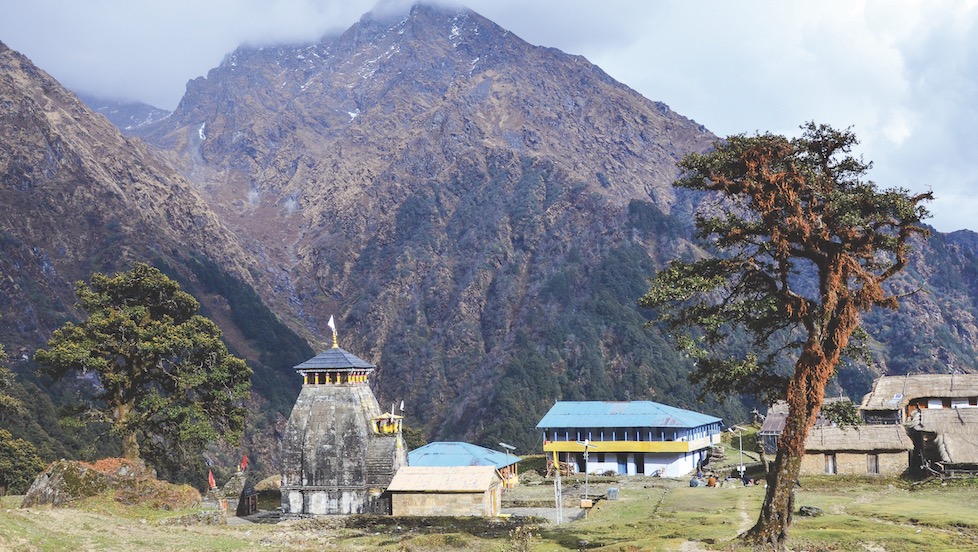ALL PHOTOS BY SCOTT RICE
Scott Rice is a devotee of Mata Amritanandamayi and a frequent volunteer with her disaster relief, humanitarian and educational projects. A retired business owner, he lives in Portland, Oregon.
PILGRIMAGE
MY MOMENTS WITH SIVA IN THE HIMALAYAS
______________________
Ascending to nearly 12,000 feet, an adventurous devotee discovers a small shrine where he and the local priest share a few blissful hours with God
______________________
BY SCOTT RICE, PORTLAND, OREGON
IN EARLY NOVEMBER, I TRAVELED TO Uttarakhand to photograph Flood Relief Projects of Mata Amritanandamayi. This is the land of Siva where the Mahabharata comes alive. While there, I hoped to trek high up in the Himalayas to visit Kedarnath at 3,600m, the famous Siva temple where thousands died in the floods of 2013.
Unfortunately, the temple had just closed for the winter. A friend suggested I go instead to Madhya Maheshwar, the middle (madhya) of the five Panch Kedar Siva Temples. As it was open for another couple of weeks, I jumped at the chance. I am a reasonably fit 65-year-old man with a pacemaker, and not a regular hiker.
Madhya Maheshwar is a 22 km trek to an altitude of 3,500 meters described in the guidebooks as “moderately difficult.” What I didn’t know is that for the first six km you go downhill, deep into the Mandakini River canyon before beginning the ascent. I rested there for the night in a primitive guest house, trying to forget the 6,000-foot elevation gain I would face in the morning.
I know my limits and capabilities. Seeing the steepness of the trail and the endless switchbacks, I knew I was in over my head, but I had no thought of turning back. One step at a time, my mantra became “I can’t believe I am doing this, Om Namah Sivaya.” As I climbed, the pure mountain air thinned of oxygen, but seemed full of Siva Shakti. Somehow it sustained me. For over five hours I was drawn up the mountain by a force greater than myself.
These final weeks before winter closing see few pilgrims. A dozen of us entered the temple for morning puja. After prasad, everyone packed their bags and disappeared back down the mountain, leaving only me and the temple staff. The priest invited me back inside for another puja. I sat alone next to the statue of Nandi and for the next two hours witnessed the most amazing display of devotion.
As the priest began to wash the Lingam, he became animated, his motions like a ballet. Chanting turned to song. He sang as a mother to her newborn child or a man to his lover. Bands of bright yellow sandalwood were applied to every possible surface of the stone, then dots of red kumkum. He placed an ornate silver dome over the Lingam. Polishing a bronze mask of Siva, he again applied sandalwood and kumkum. Bright red lips made the face come alive. Siva’s eyes flashed a piercing silver as the mask was hung on the dome. All of the other Deities were polished, anointed and arranged around Siva, each piece with equal care.
The dance of arati began. A single flame, then three, then five. The priest waved a mirror before Siva as if to say, “Look how radiant You are.” I sat in awe. Some major temples bar my entry as a foreigner. In others, the crushing crowds allow only a split second darshan with no chance for quiet contemplation.
So why was I, a Western novice to Hinduism, given this extraordinary opportunity to sit alone, face to face with Lord Siva, for more than two hours? I have no answer. I can only attempt to share the reverence and beauty of this experience through words since no photos were allowed inside. I did try to capture the amazing perch of the temple in the photos here.
Siva’s solitary sanctuary : Overview of the compound that Scott Rice (inset) stumbled on; (counterclockwise from large image) roughly sculpted bust of Siva, His head adorned with fresh sandalwood paste; Scott stands before the central shrine; buildings surrounding the shrine; the snowy Himalayas rise above; minor shrines; view of main shrine from below; lion protector; the compound; Sivalingam outside where pilgrims make offerings; the priest grinds sandalwood paste for his puja; austere quarters offer refuge from the cold


